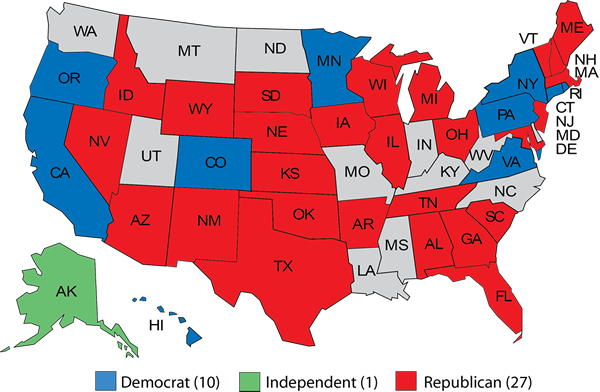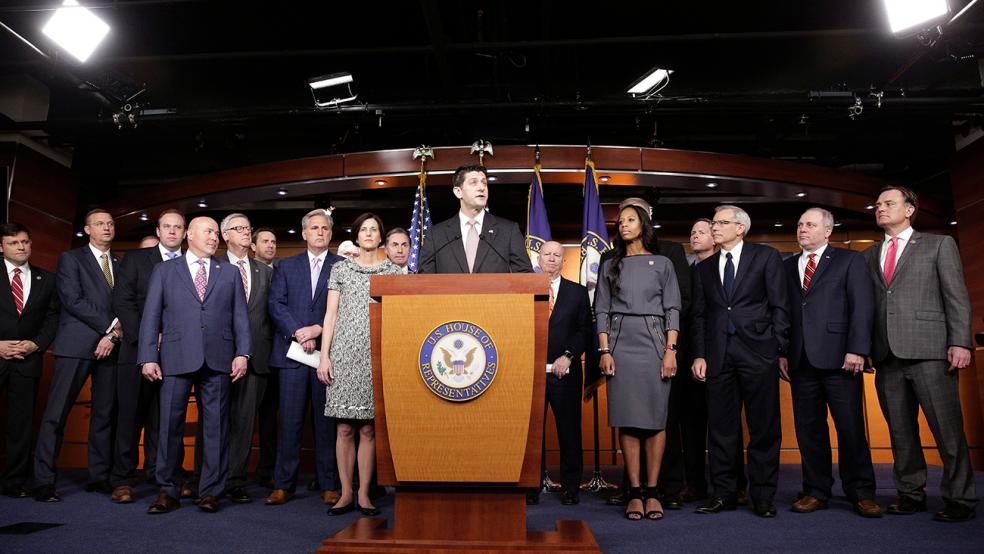President Trump and House Speaker Paul Ryan (R-WI) have fueled speculation that the House will try again to revive the Republican’s health care legislation. The latest wrinkle is an amendment that would allow states to dictate their own list of “essential” health benefits and permit insurers to charge people with preexisting conditions higher premiums under certain conditions.
If Trump and congressional Republican leaders succeed in their goal of dismantling Obamacare and shifting much of the responsibility for health care to the states, then the nation’s governors will likely have an important say in how it plays out.
Related: Republicans Are Trying Again on Obamacare Repeal: Here’s the New Plan
Currently, 33 of the nation’s 50 governors are Republicans, many of whom are sharp critics of Obamacare or opposed allowing their states to participate in expanded Medicaid for low-income adults under the Affordable Care Act.
One of the newest Republican governors, Matt Bevin of Kentucky, last year became the first governor in the country to dismantle his own state’s successful health care exchange, Kynect, and transfer policy holders to the federal exchange. In relatively short order, Bevin was able to undo many of his Democratic predecessor’s health care initiatives under Obamacare.
Meanwhile, Republican Kansas Gov. Sam Brownback recently vetoed a bipartisan bill that would have allowed the state to take advantage of expanded Medicaid for many of its low income residents under Obamacare.
The Kentucky and Kansas experiences underscore the central role that governors and state legislatures play in implementing the nation’s health care laws. And it helps to explain why the outcome of the upcoming gubernatorial races in 38 states this year and next could have a profound effect on the future of health care policy – especially if Congress ultimately shifts more responsibility to the states.
Related: How the Trump Administration Can Undermine Obamacare
Stuart Rothenberg, a veteran political analyst, said on Friday that the outcome of those races will be important for a number of reasons, not the least of which is determining which party will gain the upper hand in redistricting and reapportionment for future congressional elections.
More directly, the quality and cost of health care is almost certain to be a central issue in many of those campaigns, he said, as states gradually assume more responsibility for running health care programs, either through federal legislation or by default.
“The governors’ races are a big deal for multiple reasons,” Rothenberg said in an interview. “For an extensive period, states have had a significant role as laboratories for experimentation while Washington has had gridlock.”
“There is more opportunity for states to handle these issues because Washington just can’t deal with anything big,” said Rothenberg, senior editor at Inside Elections. “Coverage is only part of the issue, cost is part of the issue for states. And unless Washington gets its act together, which I think is extremely unlikely, the states are going to have more and more opportunity – and are going to be needed more and more to deal with some of these issues.”
Related: One Major Obamacare Insurance Company Is Close to Break Even
Twenty-seven of the 38 governorships up for election in 2017 and 2018 are currently held by Republicans; 10 Democrats and one independent hold the rest. A new analysis by University of Virginia political scientist Larry J. Sabato’s Crystal Ball political blog suggests that Republicans are “highly overextended” and thus vulnerable to Democratic challenges.
Map: Party control of state governorships being contested in 2017-2018

Source: Sabato’s Crystal Ball
Many of the governorships will be open, with roughly half of the contests devoid of an incumbent. “The high number of open seats should spur a considerable amount of party changes, which would be similar to the 2009-2010 cycle, another period where there were not a ton of incumbents on the ballot and when about half of the governorships contested changed party hands,” according to the analysis written by Geoffrey Skelley and Kyle Kondik at Sabato’s Crystal Ball.
As of now, the Crystal Ball sees Democrats winning two Republican-held seats — New Jersey and New Mexico. The tossup states that will ultimately determine the balance of power include Alaska, Colorado, Florida, Illinois, Michigan, Minnesota, Nevada and Virginia. When the dust settles, Sabato expects the Democrats to start 2019 with more governorships than they hold now.
Related: Why Congress Goes for the Gold When They Sign Up for Obamacare
Skelley said in an email that it’s too soon to predict precisely how the health care issue will play out in the campaigns and what a Democratic comeback might mean for health care policy going forward.
“Much depends on what the federal government does with Obamacare as well as on each state’s individual political and health care situation, and the elections take place next year,” he said. “A whole lot could happen between now and then.”





